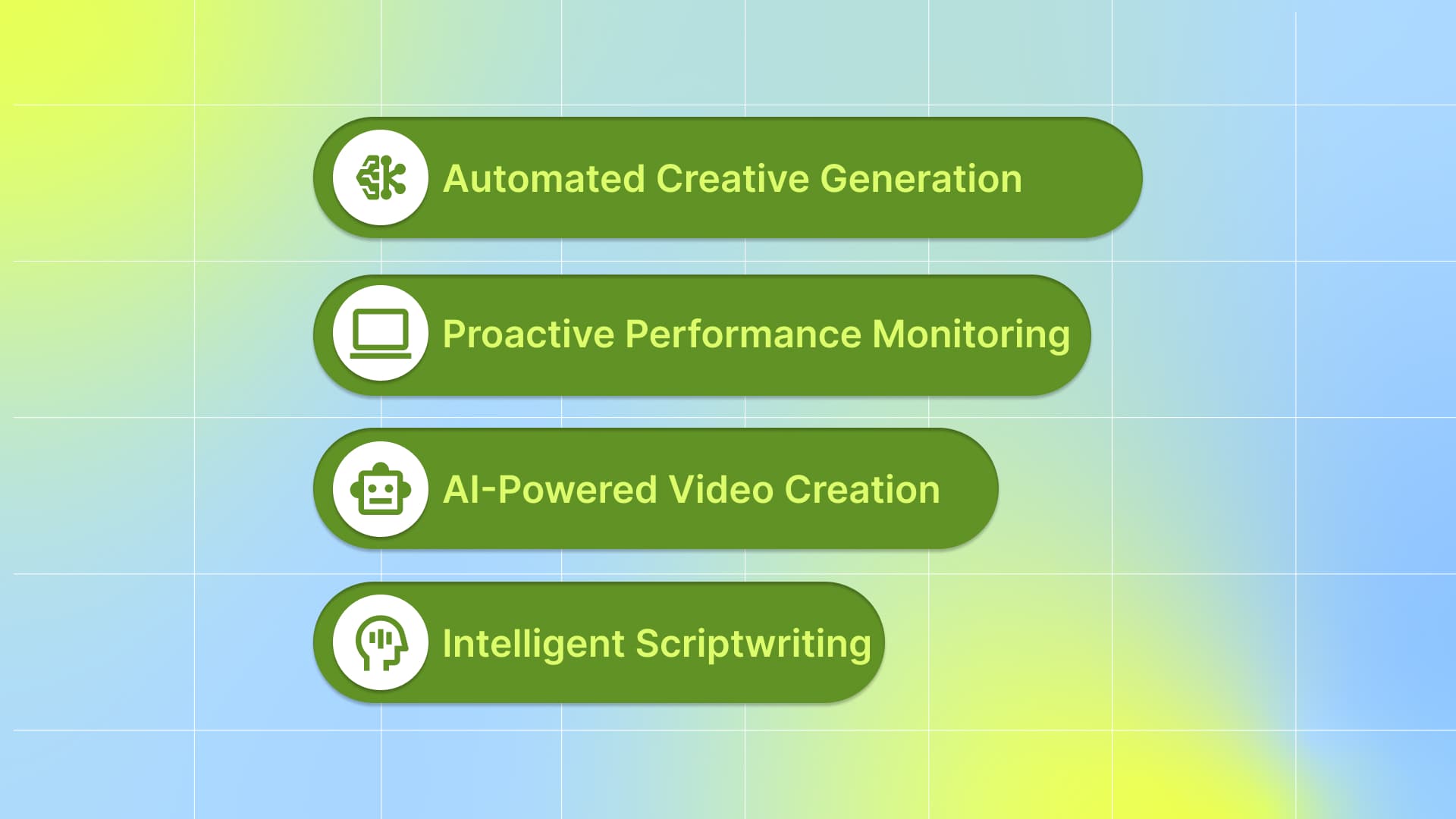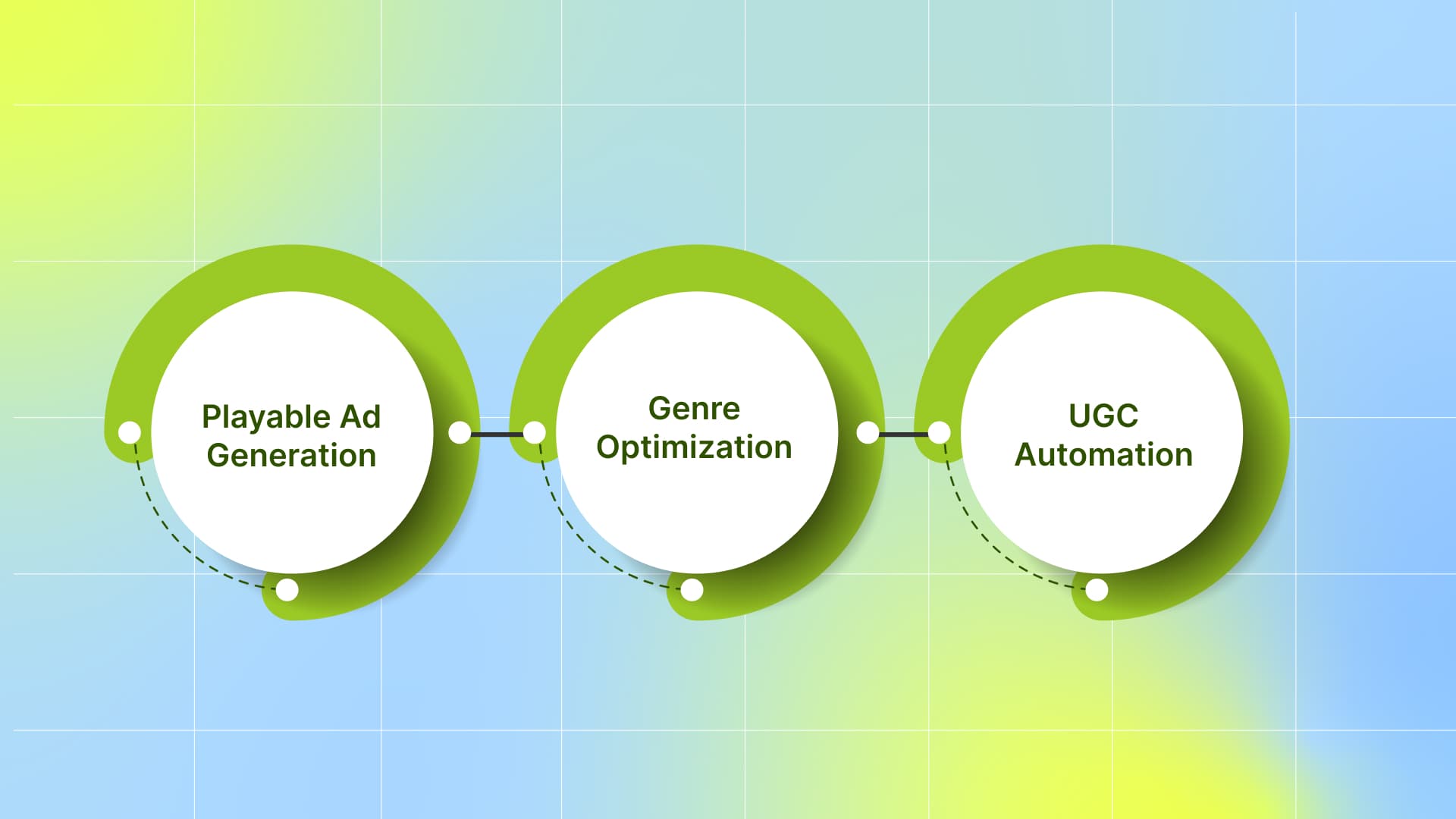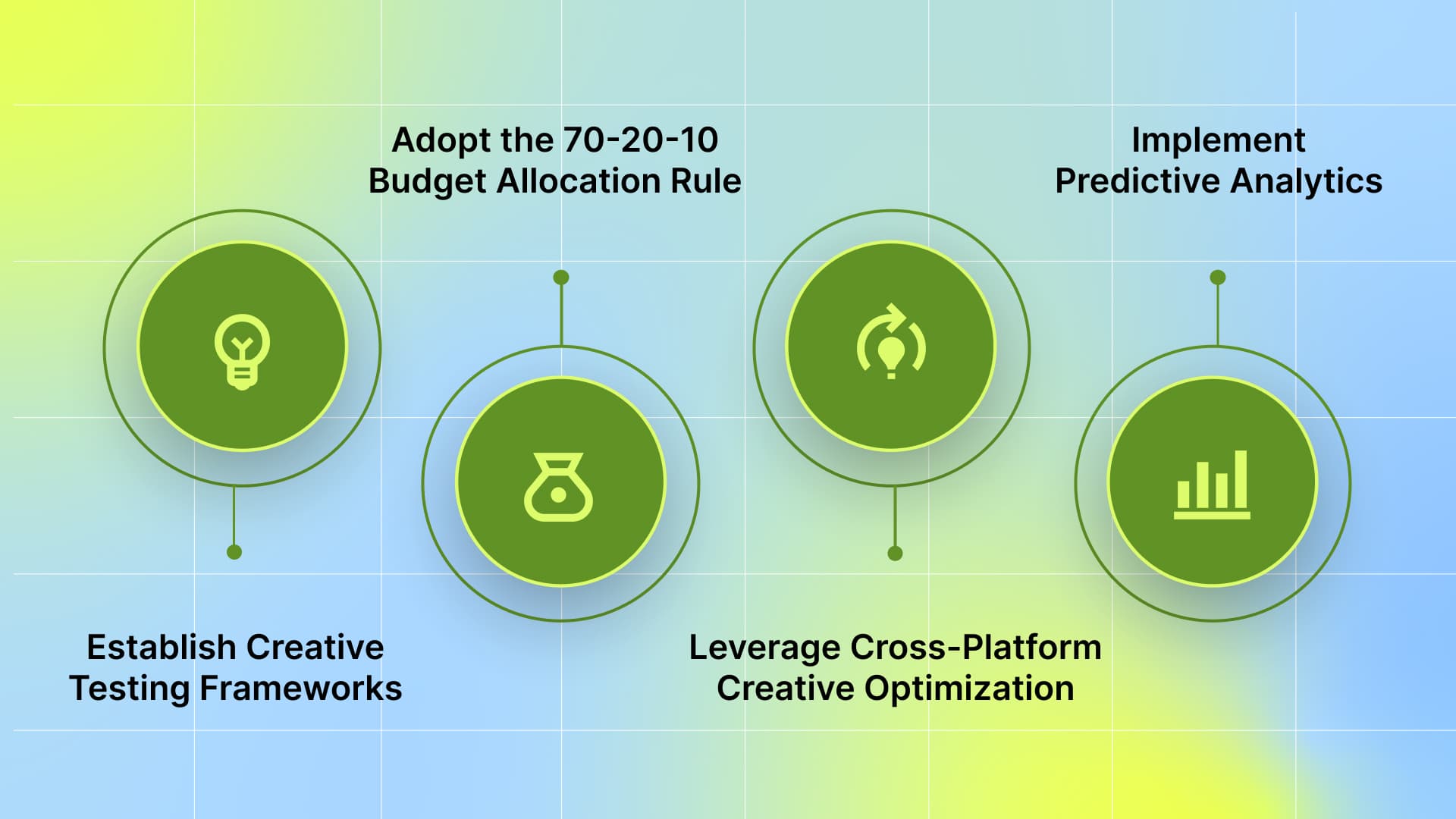How to Combat Creative Fatigue with AI Solutions
Your ads are growing invisible. Gamers scroll past familiar visuals, and repeated views lower engagement. As creatives lose impact, click-through rates drop, acquisition costs rise, and user growth slows. AI-based tools help detect early signs of fatigue, such as declining CTR, rising CPC/CPI, high ad frequency, and reduced ROAS, and respond automatically. One mobile game company reported a 52% increase in CTR using this approach.
These tools accelerate creative production, generating fresh videos, images, and localized assets while running A/B tests and applying dynamic creative optimization. They also manage frequency caps and refresh ads every 10–14 days to avoid oversaturation.
This blog will cover how to reduce creative fatigue in mobile game campaigns using AI, including how to detect it, how auto-refresh works, and how to apply gaming-specific tactics through a practical integration playbook.
What is Creative Fatigue?
Creative fatigue occurs when target audiences become desensitized to advertising content due to repeated exposure to it. In mobile gaming marketing, this occurs when players see the same ad creative too frequently, leading to a loss of interest and reduced engagement. The phenomenon is particularly damaging because it leads to declining click-through rates, increased cost per acquisition, and reduced conversion rates.
Recent research shows that creative fatigue can reduce purchase intent by up to 40% after just four ad views. For mobile gaming campaigns, this means that even high-performing creatives can quickly become ineffective if not properly managed and refreshed.
Key Signs of Creative Fatigue in Mobile Gaming
Declining click-through rate (CTR): A drop in CTR is one of the earliest and most obvious signs of creative fatigue.
Increased cost per acquisition (CPA): As engagement declines, platforms charge more per install or conversion.
Higher cost per mille (CPM): Less engaging ads lead algorithms to raise the cost for 1,000 impressions.
Decreased conversion rates: Users who click on the ads are less likely to install or make a purchase.
Shorter interaction time: Viewers drop off faster, especially noticeable in video ad view-through rates.
High ad frequency: The same users repeatedly see the ad, which correlates with a decline in performance.
Why Creative Fatigue Matters More in 2025
The mobile gaming market is highly competitive, with over 700,000 games available and new ones launching daily. Creative fatigue is now hitting harder and faster. This is especially important for mobile gaming because:
Creative dominance in performance: Meta's 2025 internal studies show that creatives now account for approximately 56% of incremental app installs, more than audience targeting or bidding strategies.
Rapid content consumption: Mobile users scroll through hundreds of ads daily, making fresh content essential for breaking through the noise.
Platform algorithm changes: Social platforms increasingly favor novel, engaging content, penalizing repetitive creatives.
Rising UA costs: As acquisition costs increase, maximizing creative efficiency becomes critical for profitability.
Given the pressure to keep content fresh and performing, AI has become an essential part of the creative process. Let’s explore how different types of AI tools address fatigue at scale.
Also Read: Enhancing Creative Campaigns with AI: Top Strategies for Performance Marketing
AI Solutions for Creative Fatigue Reduction

Artificial intelligence offers comprehensive solutions to combat creative fatigue across multiple dimensions of mobile gaming marketing. Here's how AI is transforming creative workflows in 2025:
1. Automated Creative Generation and Refresh
AI‑powered platforms like Celtraand AdCreative.ai produce large volumes of ad variants optimized for mobile games:
Key AI capabilities include:
Dynamic Creative Optimization (DCO): It automatically assembles and customizes ad elements, such as headlines and images, in real-time based on user behavior, device, and location to maximize engagement. Platforms such as Celtra empower marketers to assemble and swap headlines, images, and calls‑to‑action on the fly, driven by real‑time signals (player behavior, device, location) and deliver them programmatically across DSPs and social channels
Automated A/B and multivariate testing:Smartly.io’s AI‑powered experimentation tools bring creative production and media optimization together, reducing time‑to‑launch by up to two‑thirds compared to traditional workflows, so you can spin up, run, and evaluate multivariate tests across Meta, Unity Ads, and programmatic channels within days rather than weeks.
Template-based production: With Bannerflow’s cloud-hosted Creative Management Platform, you can plug in live game data (events, leaderboards, in-app rewards) into customizable HTML5 and video templates, instantly generating localized, player–persona-driven ads at volume without coding.
Bulk design processing:AdCreative.ai's batch mode can produce large sets of static and video ads, then rank each variant via its prediction engine, allowing you to pre-filter low-ROI concepts before deploying spend.
2. Proactive Performance Monitoring and Optimization
In mobile gaming, AI‑based platforms now offer proactive monitoring to spot creative fatigue before it hurts KPIs. They track metrics such as CTR, CPI, impressions, and ROAS and can automatically refresh ads when their effectiveness drops.
Advanced monitoring features:
Predictive fatigue alerts, which flag potential drop-offs before they occur, now enable tools like Meta Ads Manager to forecast creative fatigue within a campaign's first week.
Automated notifications trigger logic to rotate or retire underperforming creatives.
Audience and frequency control, adjusting creatives to avoid user ad overexposure and fatigue.
Dynamic budget and bid tuning, reallocating budget to top-performing assets or reweighting audience segments.
One of the most advanced tools enabling proactive, creative performance monitoring in 2025 is Segwise’s Creative Analytics AI Agent, launched in March 2025. helps mobile game marketers spot creative fatigue early. It breaks down ad creatives into components such as CTAs, characters, backgrounds, and emotional cues, then tracks how each performs across various ad networks. The tool flags when certain elements start underperforming and shows which tags are driving results.
Built on its earlier campaign alert system, it now gives deeper insight at the creative level, helping teams refresh ads faster and avoid wasted spend.
3. AI-Powered Video and Visual Content Creation
Video content remains the most effective format for mobile gaming ads, achieving CTRs 20-30% higher than those of static alternatives. AI tools now enable the rapid creation of high-quality video content tailored to specific demographics and gaming genres.
Leading AI video solutions include:
Runway for text-to-video creation and scene editing.
Lumen5 for converting gameplay content into social-ready videos.
Kaiber for AI-driven music videos and motion graphics.
Creatify for generating video ads with gameplay footage, logos, and calls to action.
These platforms can produce video creatives in minutes rather than weeks, dramatically reducing production timelines and costs while enabling extensive A/B testing.
4. Intelligent Scriptwriting and Localization
AI technologies streamline the creation of scripts and voiceovers tailored to specific demographics and regions, enabling more efficient and targeted content development. This ensures that mobile gaming ads resonate globally while maintaining the game's core narrative.
Benefits of AI-driven scriptwriting:
Rapid creation of multiple script variations for diverse audiences.
Consistent brand voice across various languages and regions.
Flexibility to test different narrative approaches.
Natural-sounding voiceovers with appropriate emotion and intonation.
Tools likeElevenLabs specialize in generating lifelike speech synthesis that adapts to different languages and dialects, making it easier for mobile gaming companies to localize their creative content efficiently.
While the above capabilities are broadly applicable, mobile gaming has unique needs. Here’s how AI is meeting them directly.
Also Read: What is Ad Fatigue? Know, Spot, and Fix!
Mobile Gaming-Specific AI Applications

The mobile gaming industry has unique creative requirements that AI solutions are specifically addressing in 2025:
1. Playable Ad Generation
Playable ads have become a central component of mobile user acquisition strategies. These interactive ads allow users to experience a mini-version of a game before downloading, leading to higher engagement and conversion rates. In 2025, the adoption of playable ads has more than doubled compared to 2024, with top publishers applying the format beyond gaming to sectors like retail, finance, and utilities.
Tools Supporting Playable Ad Generation:
Playable Factory offers tools to create, edit, and iterate 2D and 3D playable ads. Their platform enables the customization of video ads into interactive experiences without requiring coding.
Segwise's Video to Playable FREE tool launched in 2025. It enables marketers to convert existing MP4 video ads into HTML5 video embed code that can be run directly on playable ad inventory, eliminating the need to develop a fully interactive playable ad. By uploading a video, users instantly generate a video HTML embed compatible with premium playable inventory, providing easy access to premium playable ad slots optimized for performance and user engagement.
2. Genre-Specific Creative Optimization
AI platforms are analyzing genre-specific performance patterns to optimize creatives accordingly:
Casual games benefit from real gameplay demonstrations over cinematic trailers.
Mid-core games require deeper engagement strategies with immersive storylines.
Hyper-casual games focus on simple, immediately understandable mechanics.
Tools Supporting Creative Optimization:
Segwise utilizes AI-powered tagging to identify and label creative elements, including visuals, text overlays, characters, call-to-actions, and even playable ad components, across images, videos, and interactive formats. That lets teams quickly analyze what works and iterate at scale. The platform integrates with major ad networks and dashboards, enabling automated adjustments and campaign expansion.
Omneky: Utilizes machine learning to generate and test different ad creatives, analyze performance data, and launch and optimize omnichannel advertising campaigns.
3. User-Generated Content (UGC) Automation
Platforms like Poolday enable marketers to create hundreds or thousands of creative variations quickly, featuring AI avatars, synthetic voices, and scene compositing. This approach is particularly effective for hypercasual games, RPGs, and social casino games.
Tools Supporting UGC Automation:
Poolday: A self‑serve AI video ad co‑pilot that ingests your footage/scripts, combines AI avatars and voiceovers, and outputs dozens to hundreds of ad variants in minutes for media channels like TikTok, Meta, and programmatic networks.
Yahaha Studios: A low‑code UGC game engine for building fully interactive 3D, multiplayer experiences. Features include a collaborative editor (Co-Create), integrated voice and chat, and access to vast 3D asset libraries. It targets creators looking to produce immersive game content, more than one-off short ad clips.
AI is transforming every aspect of mobile gaming creatives from interactive ads to genre-specific storytelling and scalable UGC. As a result, teams are now focusing on how to maintain performance over time.
Knowing what AI can do is useful, but putting it into action requires a structured plan. Here’s how mobile UA teams can make the most of these tools.
Also Read: Creative Testing Strategies for Mobile UA Campaigns in 2025
Implementation Strategies for Mobile Gaming Teams

To effectively combat creative fatigue with AI solutions, mobile gaming marketers should follow these strategic approaches:
1. Establish Creative Testing Frameworks
Implement systematic creative testing processes that leverage AI for faster iteration cycles. Focus on testing one element at a time, whether opening hooks, reward messages, or call-to-action placement, to identify what drives engagement.
2. Adopt the 70-20-10 Budget Allocation Rule
AI systems can help optimize budget allocation by following proven frameworks:
70% goes to top-performing content
20% is directed toward new ideas
10% is reserved for experimental initiatives
Implementation tip: In your campaign budget sheet, allocate 70% to existing top performers, 20% to new concepts seeded via AI, and 10% to “moonshot” variants, reviewing and rebalancing every 7 days.
This approach ensures steady performance while uncovering new opportunities through AI-driven testing.
3. Leverage Cross-Platform Creative Optimization
Use AI tools that can automatically resize and adapt creatives for different platforms and formats. This ensures consistent messaging while optimizing for each channel's specific requirements.
4. Implement Predictive Analytics
Move beyond traditional metrics, such as Day 7 retention, by implementing predictive lifetime value (PLTV) models, which forecast the expected revenue a user will generate over time. AI-powered platforms can forecast user value across 90, 120, or even 180 days, enabling teams to make faster and smarter budget decisions.
By integrating these strategies, mobile gaming teams can streamline their creative workflows and make sharper performance decisions with the help of AI.
Also Read: Creative Analytics Explained: How To Track, Measure, And Improve Ad Performance
Conclusion
As this blog shows, staying on top of creative fatigue involves more than just noticing when your ads stop working. It requires an AI‑powered workflow that detects early warning signs, generates fresh assets at scale, and maintains high performance through continuous testing and optimization. By combining proactive monitoring of key metrics (such as CTR, CPC, ROAS, and frequency) with the automated generation of new videos, images, and localized ads, marketers can prevent audiences from tuning out and keep acquisition costs in check.
The key point is that an integrated, proactive approach, where AI not only flags fatigue but also drives content refreshes and budget adjustments, leads to measurable increases in engagement and growth without increasing manual workload.
Start a 14‑day free trial and put AI at the center of your fatigue‑busting strategy with Segwise.
FAQs
1. How does AI personalize ads to prevent fatigue?
AI utilizes dynamic creative optimization by analyzing real-time user signals, including past behavior and device type, to assemble ad elements tailored to individual preferences, thereby increasing relevance and engagement. This keeps each ad feeling new and relevant by showing different visuals and headlines to various audiences.
2. Can AI predict when an ad creative will wear out?
Predictive analytics tools use historical performance data and engagement trends, employing machine learning algorithms to forecast potential click rate declines before they happen, enabling timely creative refreshes. Marketers get advance notice and can swap or refresh creatives before costs climb.
3. What tools monitor ad health around the clock?
Solutions like Mesha’s AI constantly track metrics such as CTR, CPM, and conversion rates across channels. They send instant alerts when patterns of fatigue emerge so teams can act fast.
4. Is user‑generated content a good way to fight fatigue?
Yes. Ads featuring real customers or influencer clips often earn about 40% more engagement because people find them more relatable and trustworthy.
5. How does AI‑powered multivariate testing keep creatives fresh?
AI runs multiple ad versions simultaneously, varying images, copy, and calls-to-action to identify the combinations that hold attention best. This speeds up the process of finding and scaling winning ads before they become stale.

Comments
Your comment has been submitted successfully!